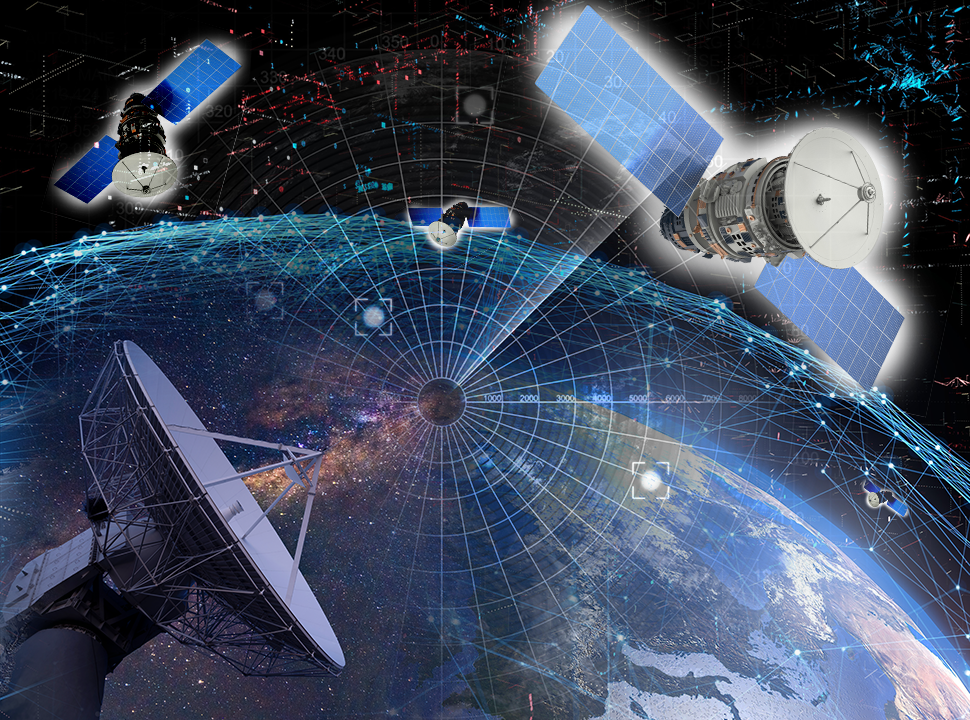3 Approaches to Track and Reduce Space Debris
3 Approaches to Track and Reduce Space Debris


There are some 27,000 objects in orbit that put satellites and spacecraft at risk. A new plan shows how to reduce and remove all of that space junk.
Decades of space missions have resulted in a field of debris orbiting Earth that is tracked by the Department of Defense’s global Space Surveillance Network (SSN) sensors. This includes 27,000 objects about the size of a softball or larger that are considered a threat to current satellites and spacecraft. This does not include nearly 170 million smaller pieces that cannot be tracked (less than 1 mm in diameter). This space junk—large and small—is a growing threat to functional satellites, spacecraft, and both manned and robotic missions.
For example, in 2021 a large hole was discovered in a 58-foot-long arm of the International Space Station (ISS) thought to be the result of an impact with an object too small to track. The year before, the ISS had to implement emergency maneuvers three separate times to avoid potential collisions with space debris.
The growing amount of orbital space debris threatens the sustainability of outer space. Potential scenarios are similar to other global, human-made environmental challenges, such as climate change. The consequences of not dealing with the retrieval and remediation of space debris will likely make many of our preferred orbital pathways unsafe to for satellites and spacecraft.
To deal with this issue, the U.S. has created an Orbital Debris Implementation Plan that focuses on:
“As space becomes congested and contested, it is critical to have combat-relevant space domain awareness (SDA),” stated Major Ed Nieto, space domain awareness optical systems deputy for U.S. Space Force. “We track more than 45,000 objects and share that data with commercial industry, joint forces, government agencies, and academic and allied partnerships. Space Systems Command [SSC] is responsible for developing, acquiring, equipping, fielding, and sustaining the systems that provide the space domain awareness to track the objects and actions that threaten U.S. capabilities.”
Listen to our Podcast: Space Stations after ISS
One of the most advanced tracking devices is U.S. Space Force’s Space Surveillance Telescope (SST), which tracks over 10,000 objects in a night. Although SST is a large optical system, the telescope and observation dome can move simultaneously to track objects with incredible speed, providing higher sensitivity, resolution, and capacity compared to traditional legacy electro-optical sensors, while being as quiet as a microwave during operations.
The 3.5-meter aperture mirror, paired with the large curved focal surface array sensors, are an innovative advancement. The combination of detecting small dim objects with low reflectivity in geosynchronous orbit (about 22,000 miles above Earth) with being able to quickly search an entire target area, “is a difficult achievement accomplished from a single telescope design,” said Jonathan Hutfilz, space surveillance telescope program manager. “SST is also one of the world's most agile telescopes of its size, thanks to its advanced servo-control technology. The 232-ton system is so extremely well-balanced that a single person can push the telescope mount so it can move in azimuth.”
Here are three approaches for tracking and reducing the amount of debris in space:
On-Earth radars can track objects as small as two centimeters in width; however, it is imperative to reduce future risks to satellites and spacecraft by developing radar that can track these small objects. Mechanical engineers are in great demand for designing and building the ground and space telescopes needed to track both large and miniscule objects in space.
Try this Aerospace Quiz: Aerospace and the Digital Transformation
“Engineers are also critical in the development of sensors used to track space debris,” said Nieto. “More advanced and sensitive sensors are required to track ever smaller and greater numbers of objects in orbits. Optimizing performance within cost constraints drives industry to innovative sensor designs and manufacturing techniques.”
The goal of remediation is to send improved equipment into space that is designed to last longer and reduce the amount of debris that these satellites and spacecraft shed during their lifetimes in orbit, and at their demise. Designing launch vehicles that can be reused rather than destroyed upon return to Earth is another way to reduce junk accumulation in space, such as the safe return of SpaceX Falcon 9 rockets that launch Starlink satellites.
SpaceX puts it like this: “With space sustainability in mind, we have pushed state-of-the-art in key technology areas like flying satellites at challenging low altitudes, using sustainable electric propulsion for maneuvering and active de-orbit, and employing inter-satellite optical communications to constantly maintain contact with satellites.”
Several private companies are involved are developing innovative spacecraft that will capture and remove space junk from orbit. For example, Astroscale plans to launch a vehicle that will capture defunct satellites and take them into lower Earth orbit, where both burn up in the atmosphere.
Another example of ingenuity is the use of spinning magnets to redirect space junk into deeper space. Mechanical engineers at the University of Utah have discovered that multiple, rotating magnetic-field sources can move a target object in six degrees, including rotation, without physical contact. The changing magnetic field essentially turns the piece of debris into an electromagnet, which the spinning magnets can then direct out of orbit and into deeper space, without having to physically grab and redirect it.
More for You: The Growth of Additive Manufacturing in Aerospace
What are the greatest roles for MEs in designing future tools and technologies needed for tracking and removing space debris?
Optical sensors is a big one, noted Christian Randell, chief engineer for ground-based optical sensor systems for U.S. Space Force. “Space Force sensors tend to be one of highly specialized sensors, where size, sensitivity, and reliability are key,” he said. “Engineering 3.5-meter optics with remarkably tight optical prescriptions is an amazing feat.”
Another role is in commercial space domain awareness (SDA).
“Among the many challenges in SDA, there are two key focus areas for MEs,” Randell continued. “One is preserving an industrial base for manufacturing highly specialized, advanced sensor components, which will drive the need for exploring dual-use applications to share the development burden. The other is driving affordability with ever-increasing performance and reducing reliance on vulnerable supply chains—both are key to future success.”
Mark Crawford in a science and technology writer in Corrales, N.M.
For example, in 2021 a large hole was discovered in a 58-foot-long arm of the International Space Station (ISS) thought to be the result of an impact with an object too small to track. The year before, the ISS had to implement emergency maneuvers three separate times to avoid potential collisions with space debris.
The growing amount of orbital space debris threatens the sustainability of outer space. Potential scenarios are similar to other global, human-made environmental challenges, such as climate change. The consequences of not dealing with the retrieval and remediation of space debris will likely make many of our preferred orbital pathways unsafe to for satellites and spacecraft.
To deal with this issue, the U.S. has created an Orbital Debris Implementation Plan that focuses on:
- Debris mitigation by designing future spacecraft in ways that will minimize the amount of debris they create during their lifetime in space.
- Tracking and characterizing debris by supporting new technologies that enhances the detection, tracking, or characterization of space debris, especially smaller objects.
- Remediation of debris by developing new methods and technologies for capturing and removing space debris and improving collision-avoidance techniques.
“As space becomes congested and contested, it is critical to have combat-relevant space domain awareness (SDA),” stated Major Ed Nieto, space domain awareness optical systems deputy for U.S. Space Force. “We track more than 45,000 objects and share that data with commercial industry, joint forces, government agencies, and academic and allied partnerships. Space Systems Command [SSC] is responsible for developing, acquiring, equipping, fielding, and sustaining the systems that provide the space domain awareness to track the objects and actions that threaten U.S. capabilities.”
Listen to our Podcast: Space Stations after ISS
One of the most advanced tracking devices is U.S. Space Force’s Space Surveillance Telescope (SST), which tracks over 10,000 objects in a night. Although SST is a large optical system, the telescope and observation dome can move simultaneously to track objects with incredible speed, providing higher sensitivity, resolution, and capacity compared to traditional legacy electro-optical sensors, while being as quiet as a microwave during operations.
The 3.5-meter aperture mirror, paired with the large curved focal surface array sensors, are an innovative advancement. The combination of detecting small dim objects with low reflectivity in geosynchronous orbit (about 22,000 miles above Earth) with being able to quickly search an entire target area, “is a difficult achievement accomplished from a single telescope design,” said Jonathan Hutfilz, space surveillance telescope program manager. “SST is also one of the world's most agile telescopes of its size, thanks to its advanced servo-control technology. The 232-ton system is so extremely well-balanced that a single person can push the telescope mount so it can move in azimuth.”
Here are three approaches for tracking and reducing the amount of debris in space:
Tracking with Radar
On-Earth radars can track objects as small as two centimeters in width; however, it is imperative to reduce future risks to satellites and spacecraft by developing radar that can track these small objects. Mechanical engineers are in great demand for designing and building the ground and space telescopes needed to track both large and miniscule objects in space.
Try this Aerospace Quiz: Aerospace and the Digital Transformation
“Engineers are also critical in the development of sensors used to track space debris,” said Nieto. “More advanced and sensitive sensors are required to track ever smaller and greater numbers of objects in orbits. Optimizing performance within cost constraints drives industry to innovative sensor designs and manufacturing techniques.”
Remediation through improved design
The goal of remediation is to send improved equipment into space that is designed to last longer and reduce the amount of debris that these satellites and spacecraft shed during their lifetimes in orbit, and at their demise. Designing launch vehicles that can be reused rather than destroyed upon return to Earth is another way to reduce junk accumulation in space, such as the safe return of SpaceX Falcon 9 rockets that launch Starlink satellites.
SpaceX puts it like this: “With space sustainability in mind, we have pushed state-of-the-art in key technology areas like flying satellites at challenging low altitudes, using sustainable electric propulsion for maneuvering and active de-orbit, and employing inter-satellite optical communications to constantly maintain contact with satellites.”
Retrieval of space debris
Several private companies are involved are developing innovative spacecraft that will capture and remove space junk from orbit. For example, Astroscale plans to launch a vehicle that will capture defunct satellites and take them into lower Earth orbit, where both burn up in the atmosphere.
Another example of ingenuity is the use of spinning magnets to redirect space junk into deeper space. Mechanical engineers at the University of Utah have discovered that multiple, rotating magnetic-field sources can move a target object in six degrees, including rotation, without physical contact. The changing magnetic field essentially turns the piece of debris into an electromagnet, which the spinning magnets can then direct out of orbit and into deeper space, without having to physically grab and redirect it.
More for You: The Growth of Additive Manufacturing in Aerospace
What are the greatest roles for MEs in designing future tools and technologies needed for tracking and removing space debris?
Optical sensors is a big one, noted Christian Randell, chief engineer for ground-based optical sensor systems for U.S. Space Force. “Space Force sensors tend to be one of highly specialized sensors, where size, sensitivity, and reliability are key,” he said. “Engineering 3.5-meter optics with remarkably tight optical prescriptions is an amazing feat.”
Another role is in commercial space domain awareness (SDA).
“Among the many challenges in SDA, there are two key focus areas for MEs,” Randell continued. “One is preserving an industrial base for manufacturing highly specialized, advanced sensor components, which will drive the need for exploring dual-use applications to share the development burden. The other is driving affordability with ever-increasing performance and reducing reliance on vulnerable supply chains—both are key to future success.”
Mark Crawford in a science and technology writer in Corrales, N.M.



